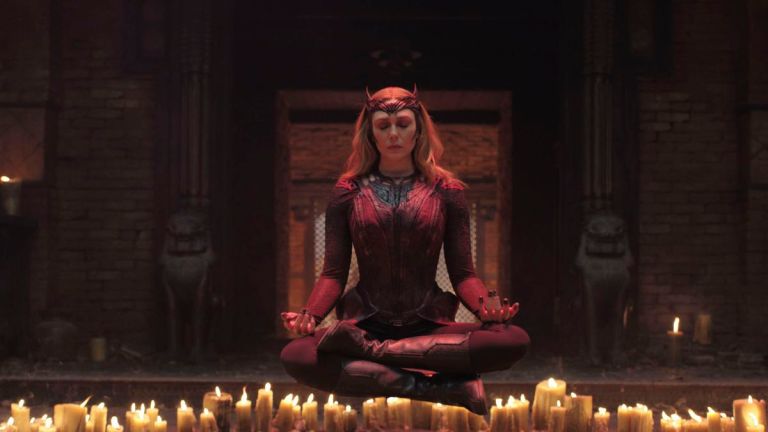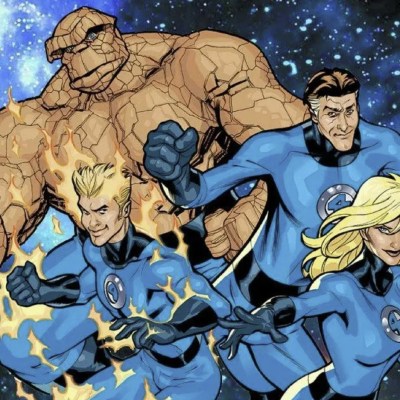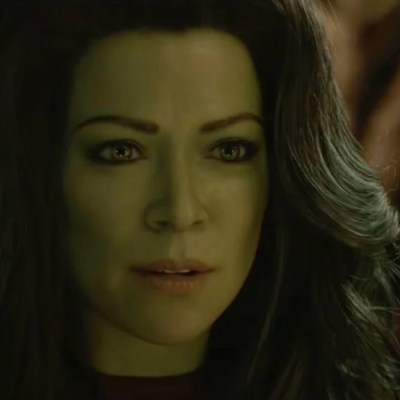Are Marvel Audiences Rejecting Distinct Directorial Style in the MCU?
The mixed audience reaction to Doctor Strange in the Multiverse of Madness, as well as Eternals, raises questions about what audiences want from Marvel Studios movies.

This article contains Doctor Strange in the Multiverse of Madness spoilers.
Marvel Studios is in absurdly fine financial shape. It seems odd to state that out loud, but given the “sky is falling” pieces running lately, it feels pertinent to remind folks of this fact. Their latest film, Doctor Strange in the Multiverse of Madness, has grossed $700 million worldwide to date while being in theaters for less than two weeks. It will certainly cross $800 million. Considering the first Doctor Strange tapped out at $677 million worldwide, and opened at less than half what the sequel did, this is a commercial win for a studio that can still demonstrate audience-brand loyalty to a stunning degree.
Perhaps then it is the envy of that loyalty—and the fact that studios have spent most of the last decade attempting to emulate it to mixed results—which speaks to the real doom and gloom write-ups circling Doctor Strange 2’s reception. If a Marvel movie is not able to hold up the entire roof of theatrical exhibition, what hope do the rest of us have?! Hence some box office analysts lecturing Marvel Studios president Kevin Feige on how to properly handle test screenings and “plus” his studio’s output.
Conversely, the opening of Multiverse of Madness reconfirms the trust audiences have in the Marvel brand. After all, recall how just 11 years ago Marvel Studios was hesitant to even admit magic existed in the first Thor movie. Now Doctor Strange and Scarlet Witch, complete with strange magic and witchcraft, lead a blockbuster that can open within spitting distance of $200 million domestic…
Nevertheless, there are some possible lessons, grim ones, even, to be had in the movie’s overall box office performance.
Commercial Evidence of a Mixed Reception
While the Sam Raimi-directed Doctor Strange movie is an unqualified box office success, the word of mouth around the picture is mixed. It is these imperfections that are giving an industry that relies on Marvel to be the market leader pause. Despite opening at a gargantuan $187 million during the first weekend of May in the U.S., Multiverse of Madness’ debut was still slightly muted given how big its opening day was.
Indeed, in its first full day of release, Friday, May 6, the Sorcerer Supreme grossed $90.7 million (that includes Thursday night previews). Typically, Marvel movies rise in their grosses on Saturday as more folks have time off to spend at the theater, particularly if they want to bring their kids. Yet Doctor Strange 2 dropped more than 36 percent on its second day, earning $57.8 million. It was this unexpectedly steep dip that caused forecasters to get initial Saturday projections of a $200 million gross wrong. And the cause for this drop seemed to be indicative of less than enthusiastic word-of-mouth. Soon enough we had the industry pollsters at CinemaScore give the movie a “B+,” which is considered faintly disappointing by most studios as it likewise suggests a lack of the enthusiasm needed for mass audiences to recommend a movie to friends and family.
Meanwhile fans bickered on social media for the following week about whether Multiverse of Madness was top tier or bottom of the shelf Marvel. Well, we got a clear idea what the majority of audiences thought this past weekend when the sequel dropped a precipitous 67 percent in its second weekend. And when your second weekend is not on Christmas or another major holiday, that’s the type of number to suggest a considerable percentage of audience members were ambivalent and box office legs are going to vanish fast.
So Marvel is not in crisis, but they do have a movie that lacks the ecstatic word-of-mouth of Spider-Man: No Way Home or Avengers: Endgame despite, like both of those, featuring multiple fan servicing cameos. So why the general disappointment?
Too Much Flavor in My Marvel Movie?
If one turns back to the backlash faced by the movie at its release from critics and fans, critiques range from the valid (such as the reductive treatment of Elizabeth Olsen’s Wanda after WandaVision) to the misguided (Scarlet Witch is too scary!). Yet through it all, one of the most intriguing complaints is that it doesn’t feel like a Marvel movie.
Initially, this rang oddly to my ears since from its opening logo to its bevy of comic book easter eggs and self-deprecating quips—plus an entirely superfluous sequel-advertisement in a post-credits scene—this is a textbook Marvel Studios project. What this criticism seems to really be about is that it doesn’t feel as innocuous and smoothed out as a typical corporate product from Disney.
Feige is a longtime friend of director Raimi and apparently worked hard to convince Raimi to come out of superhero movie retirement following his famous frustrations with Spider-Man 3. As an apparent consequence, Raimi seems to have had a freer hand than most MCU directors when crafting a movie that was still extremely interconnected with other Marvel movies and TV shows. It’s part of the same restaurant, but with a different, bolder flavor.
When trades incredulously published articles suggesting Doctor Strange in the Multiverse of Madness should be rated R, what they might have really been saying is that after more than a decade since The Avengers, a lot of folks have forgotten PG-13 movies intended for a wide audience can have an edge or distinct voice. Doctor Strange 2 is hardly any more violent or frightening than, say, Indiana Jones and the Temple of Doom (1984), the movie the PG-13 rating was invented for, nor certainly any darker than The Dark Knight, which opened to massive acclaim the same year the MCU launched via Iron Man in 2008.
But unlike any Marvel Studios movie before it, Doctor Strange in the Multiverse of Madness leaned into macabre and Gothic sensibilities. It’s still less grotesque than Raimi’s own truly too-scary-for-kids Drag Me to Hell (which is also a PG-13), and I would argue no harder edged than Tim Burton’s early family friendly output in the late 1980s and early ‘90s, but MoM has bite. And for audiences now conditioned (or even primarily reared) on Marvel Studios movies, that is becoming a foreign, unpleasant concept.
This unpleasantness comes from more than just the violence. Sure, there’s plenty of online wincing at how brutally fan favorites like Patrick Stewart’s Professor X or the dream casting of John Krasinski as Reed Richards were dispatched with Raimi’s distinctly mean-spirited sense of humor. But there’s almost as much unhappiness over the movie indulging a general goofiness outside the sitcom-like box that’s become a prerequisite for MCU banter since 2012. I’m talking about Bruce Campbell slapping himself like he’s a one-man reenactment of The Three Stooges (or just playing the hits from Evil Dead II). That type of goofy.
For audience members who are fond of Raimi’s quirks and eccentricities, it was like seeing an old friend when Campbell’s five fingers struck his own face; but for those who like the Marvel formula’s sense of humor exactly where it usually is, it might be off-putting. The same would apply for the climactic moment that’s intentionally undercut by Raimi. You know, it’s that boilerplate Disney moment where the moral of the story is exposited, in this case as Doctor Strange obligatorily tells America Chavez (Xochitl Gomez) that the power she’s been looking for was inside of her all along. It’s the type of saccharine beat modern audiences expect in all superhero movies, but perhaps knowing how lightweight the material is in this particular instance, Raimi transgressively mocks it by having a zombified Strange deliver his speech in a close-up as interested in his decaying lips as it is the dialogue.
Can Disappointment Affect Future Marvel Movies?
I’m still not entirely convinced Raimi’s stylistic flourishes are the primary reason for Doctor Strange 2’s mixed reception. Personally, I think Marvel films are increasingly running the risk of crossing the Rubicon discovered by comic books in the 1990s—a time when the continuity went on for so long that the characters became impenetrable and alienating to newcomers or younger viewers who lack the interest (or income) to read/watch every Marvel story and spinoff.
Be that as it may, there is a vocal backlash among fans toward elements that can be traced to Raimi and anything that just hints at a sideways point-of-view on the material. You can hear it echoed in tweets bemoaning the groovy scene where Doctor Strange fights himself by firing musical notes at his doppelganger—Heaven forbid a CGI slugfest do something different. You either like it or you hate it, and a vocal segment of the fans hate it. And if Star Wars: The Rise of Skywalker’s patchworked birth suggests anything, it’s that Disney is very keen to listen to the loudest complaints on the internet.
Additionally, Doctor Strange isn’t the only Phase 4 Marvel movie to give a director a larger degree of autonomy to mixed fan results. Last year’s Eternals became the rare box office misfire for Marvel Studios, and the first to receive a “rotten” score on the aggregate site Rotten Tomatoes. It’s impossible to ignore the similar criticisms that (far more uneven) picture faced too, even from critics: this doesn’t feel like Marvel. Why would director Chloé Zhao dare consider coloring outside the lines?
I’m not sure most audience members actually have an issue with this exact element of Marvel, or would spend time articulating it on social media. But a growing sentiment online, even among Rotten Tomatoes-approved critics, ultimately boils down to “we like these better when they feel exactly like the others.”
That wasn’t always the case, such as when James Gunn’s subversively trippy Guardians of the Galaxy made a talking raccoon cool. But that was eight years ago and at the relative beginning of Marvel’s dominance of pop culture. Nowadays, it’s an open question whether audiences actually want “different” anymore, and for better or worse Hollywood history suggests that when creative risk becomes a commercial risk, you’ll get neither.


